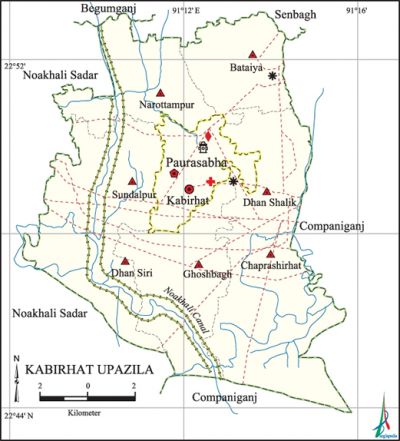Kabirhat Upazila
Kabirhat Upazila (noakhali district) area 189.94 sq km, located in between 22°44' and 22°53' north latitudes and in between 91°08' and 91°15' east longitudes. It is bounded by begumganj and senbagh upazilas on the north, companiganj upazila on the south, Companiganj upazila on the east, noakhali sadar upazila on the west.
Population Total 167270; male 83363, female 83907.
Water body Noakhali Canal.
Administration Kabirhat upazila was formed on 6 August 2006 comprising parts of Noakhali Sadar upazila.
| Upazila | ||||||||
| Municipality | Union | Mouza | Village | Population | Density (per sq km) | Literacy rate (%) | ||
| Urban | Rural | Urban | Rural | |||||
|
1 |
7 |
67 |
67 |
16156 |
151114 |
881 |
71.14 |
53.86 |
| Municipality | |||||
|
Area (per sq km) |
Wards |
Mahalla |
Population |
Density (per sq km) |
Literacy rate (%) |
|
9.32 |
9 |
11 |
16156 |
1733 |
71.14 |
| Union | ||||
| Name of union and GO code | Area (acre) | Population | Literacy rate (%) | |
| Male | Female | |||
|
Ghoshbagh 55 |
7969 |
9765 |
10125 |
53.52 |
|
Chaprashirhat 27 |
11942 |
10913 |
11717 |
47.91 |
|
Dhan Shalik |
3408 |
5674 |
5724 |
57.56 |
|
Dhan Siri |
6530 |
17002 |
16963 |
31.97 |
|
Narottampur 70 |
3853 |
11616 |
11617 |
63.46 |
|
Bataiya 23 |
3621 |
10339 |
10859 |
52.09 |
|
Sundalpur 95 |
7833 |
9852 |
25911 |
45.22 |
Source Bangladesh Population Census 2001,Bangladesh Bureau of Statistics.
Archaeological heritage and relics Kabir Patwary Jami Mosque at village Ghoshbagh (Mughal period), three domed Hoiya Miah Mosque and mazar of Chhankhola Darvish (Narottampur union).

History of the War of Liberation During the war of liberation in 1971, the local razakars established a camp at the Kabirhat High School. On 27 September, the Pak army in collaboration with the razakars conducted heavy torture and plundering in Company Hat area and in village Alipur of Ghoshbagh union; they also set many houses of this area on fire. On 17 October, the freedom fighters launched an attack on the house of razakar Jalil in which Jalil was killed and so were a number of his compatriots.
Marks of the War of Liberation Slaughter place 1 (ditch on the eastern side of the Kabirhat High School).
Literacy rate and educational institutions Average literacy 55.83%; male 58.76%, female 52.91%. Educational institutions:' college 2, secondary school 25, primary school 87, madrasa 8. Noted educational institutions: Kabirhat Government College (1967), Chaprashirhat High School (1913), Kabirhat High School (1938), Chaprashirhat Madrasa (1901), Kabirhat Madrasa (1905).
Cultural organisation Library 1.
Main crops Paddy, jute, pulses, vegetables.
Main fruits Mango, blackberry, plum, dates, coconut, betel nut.
Communication facilities Pucca road 78 km, mud road 298 km.
Hats, bazars and fairs Hats and bazars are 20, most noted of which are Chaprashirhat, Kabirhat, Kalir Hat, Bhuiyan Hat, and Karam Bazar.
Sources of drinking water The presence of arsenic in an intolerable level has been detected in the shallow tube-well water of the upazila.
Health centres Hospital 1, satellite clinic 9.
Natural disasters The cyclones and floods of 12 November 1970 and 29 April 1991 caused heavy damages to settlements, livestock and crops of the upazila.
NGO activities NRDS. [AM Saiful Islam]
References Bangladesh Population Census 2001, Bangladesh Bureau of Statistics; Field report of Kabirhat Upazila 2007.
